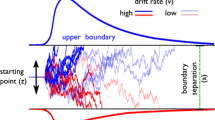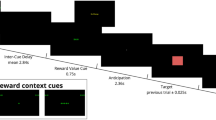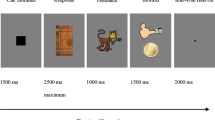Abstract
The current studies utilized drift diffusion modeling (DDM) to examine how reinforcement and stimulant medication affect cognitive task performance in children with ADHD. In Study 1, children with (n = 25; 88 % male) and without ADHD (n = 33; 82 % male) completed a 2-choice discrimination task at baseline (100 trials) and again a week later under alternating reinforcement and no-reinforcement contingencies (400 trials total). In Study 2, participants with ADHD (n = 29; 72 % male) completed a double-blind, placebo-controlled trial of 0.3 and 0.6 mg/kg methylphenidate and completed the same task utilized in Study 1 at baseline (100 trials). Children with ADHD accumulated information at a much slower rate than controls, as evidenced by a lower drift rate. Groups were similar in nondecision time and boundary separation. Both reinforcement and stimulant medication markedly improved drift rate in children with ADHD (ds = 0.70 and 0.95 for reinforcement and methylphenidate, respectively); both treatments also reduced boundary separation (ds = 0.70 and 0.39). Reinforcement, which emphasized speeded accuracy, reduced nondecision time (d = 0.37), whereas stimulant medication increased nondecision time (d = 0.38). These studies provide initial evidence that frontline treatments for ADHD primarily impact cognitive performance in youth with ADHD by improving the speed/efficiency of information accumulation. Treatment effects on other DDM parameters may vary between treatments or interact with task parameters (number of trials, task difficulty). DDM, in conjunction with other approaches, may be helpful in clarifying the specific cognitive processes that are disrupted in ADHD, as well as the basic mechanisms that underlie the efficacy of ADHD treatments.



Similar content being viewed by others
Notes
We do not compare baseline (visit 1) DDM parameters to the reinforcement manipulation (visit 2) parameters because of task differences, including the number of trials, length of trials (which changes event rate), and the addition of task stimuli (i.e., reinforcement feedback).
Preliminary screening of the data revealed a subgroup of 6 control group and 3 ADHD group children with atypically high (>3 SDs above the mean) boundary separation. Because of the size of the subgroup, and the fact that this subgroup did not differ from the rest of the sample on obvious variables such as sex, age, IQ, mean RT, or comorbid symptoms, we retained them in the primary analysis. In a supplemental analysis that excluded these participants, children in the ADHD group exhibit significantly higher boundary separation than controls, F(1, 48) = 12.2, p = 0.001, d = 0.97. Other DDM parameters were not characterized by extreme subgroups or outliers.
When the four outliers were included in the analyses, MPH continued to improve drift rate, active MPH vs. placebo F(1, 31) = 21.7, p < 0.001; 0.3 mg/kg vs. 0.6 mg/kg F(1, 31) = 4.5, p = 0.04. However, MPH no longer significantly affected nondecision time, F(1, 31) = 0.60, p = 0.45, or boundary separation, F(1, 31) = 0.01, p = 0.95; 0.3 vs. 0.6 mg/kg ps > 0.25.
References
Alderson, R. M., Rapport, M. D., Sarver, D. E., & Kofler, M. J. (2008). ADHD and behavioral inhibition: a re-examination of the stop-signal task. Journal of Abnormal Child Psychology, 36, 989–998.
American Academy of Pediatrics (2011). ADHD: clinical practice guideline for the diagnosis, evaluation, and treatment of attention-deficit/hyperactivity disorder in children and adolescents. Pediatrics, 128, 1007–1022.
American Psychiatric Association (2000). Diagnostic and statistical manual of mental disorders (4th ed.). Washington, DC: American Psychiatric Association.
Bedard, A. C., Martinussen, R., Ickowicz, A., & Tannock, R. (2004). Methylphenidate improves visual-spatial memory in children with attention-deficits/hyperactivity disorder. Journal of the American Academy of Child and Adolescent Psychiatry, 43, 260–268.
Bubnik, M. G., Hawk Jr., L. W., Pelham Jr., W. E., Waxmonsky, J. G., & Rosch, K. S. (2015). Reinforcement enhances vigilance among children with ADHD: comparisons to typically-developing children and to the effects of methylphenidate. Journal of Abnormal Child Psychology, 43, 149–161.
DeVito, E. E., Blackwell, A. D., Clark, L., Kent, L., Dezsery, A. M., Turner, D. C., & Sahakian, B. J. (2009). Methylphenidate improves response inhibition but not reflection-impulsivity in children with attention deficit hyperactivity disorder (ADHD). Psychopharmacology, 202, 531–539.
Dovis, S., Van der Oord, S., Wiers, R. W., & Prins, P. J. M. (2013). Can motivation normalize working memory and task persistence in children with attention-deficit/hyperactivity disorder? The effects of money and computer gaming. Journal of Abnormal Child Psychology, 40, 669–681.
Epstein, J. N., Brinkman, W. B., Froehlich, T., Langberg, J. M., Narad, M. E., Antonini, T. A., & Altaye, M. (2011). Effects of stimulant medication, incentives, and event rate on reaction time variability in children with ADHD. Neuropsychopharmacology, 36, 1060–1072.
Fabiano, G. A., Pelham, W. E., Waschbusch, D. A., Gnagy, E. M., Lahey, B. B., Chronis, A. M., et al. (2006). A practical measure of impairment: psychometric properties of the impairment rating scale in samples of children with attention deficit hyperactivity disorder and two school-based samples. Journal of Clinical Child & Adolescent Psychology, 35, 369–385.
Fabiano, G. A., Pelham Jr., W. E., Coles, E. K., Gnagy, E. M., Chronis-Tuscano, A., & O’Connor, B. C. (2009). A meta-analysis of behavioral treatments for attention-deficit/hyperactivity disorder. Clinical Psychology Review, 29, 129–140.
Fosco, W. D., Hawk, L. W., Jr., Rosch, K. S., & Bubnik, M. G. (2015). Evaluating cognitive and motivational accounts of greater reinforcement effects among children with attention-deficit/hyperactivity disorder. Behavioral and Brain Functions, 11. Retrieved from https://behavioralandbrainfunctions.biomedcentral.com/articles/10.1186/s12993-015-0065-9
Huang-Pollock, C. L., Karalunas, S. L., Tam, H., & Moore, A. N. (2012). Evaluating vigilance deficits in ADHD: a meta-analysis of CPT performance. Journal of Abnormal Psychology, 121, 360–371.
Huang-Pollock, C., Ratcliff, R., McKoon, G., Shapiro, Z., Weigard, A., & Galloway-Long, H. (2016). Using the diffusion model to explain cognitive deficits in attention deficit hyperactivity disorder. Journal of Abnormal Child Psychology, 1–12.
Jepma, M., Wagenmakers, E. J., Band, G. P., & Nieuwenhuis, S. (2009). The effects of accessory stimuli on information processing: evidence from electrophysiology and a diffusion model analysis. Journal of Cognitive Neuroscience, 21, 847–864.
Karalunas, S. L., & Huang-Pollock, C. L. (2013). Integrating impairments in reaction time and executive function using a diffusion model framework. Journal of Abnormal Child Psychology, 41, 837–850.
Karalunas, S. L., Geurts, H. M., Konrad, K., Bender, S., & Nigg, J. (2014). Annual research review: reaction time variability in ADHD and autism spectrum disorders: measurements and mechanisms of a proposed trans-diagnostic phenotype. Journal of Child Psychology and Psychiatry, 55, 685–710.
Kofler, M. J., Rapport, M. D., Sarver, D. E., Raiker, J. S., Orban, S. A., Friedman, L. M., & Kolomeyer, E. G. (2013). Reaction time variability in ADHD: a meta-analytic review of 319 studies. Clinical Psychology Review, 33, 795–811.
Kuntsi, J. (2014). Commentary: from noise to insight? Reaction time variability in ADHD and autism spectrum disorders- a commentary on Karalunas et al. (2014). Journal of Child Psychology and Psychiatry, 55, 711–713.
Lijffijt, M., Kenemans, J. L., Verbaten, M. N., & van Engeland, H. (2005). A meta-analytic review of stopping performance in attention-deficits/hyperactivity disorder: deficient inhibitory motor control? Journal of Abnormal Psychology, 114, 216–222.
Lipszyc, J., & Schachar, R. (2010). Inhibitory control and psychopathology: a meta-analysis of the stop signal task. Journal of the International Neuropsychological Society, 16, 1064–1076.
Luman, M., Oosterlann, J., & Sergeant, J. A. (2005). The impact of reinforcement contingencies on AD/HD: a review and theoretical appraisal. Clinical Psychology Review, 25, 183–213.
Ma, I., van Duijvenvoorde, A., & Scheres, A. (2016). Interaction between reinforcement and inhibitory control in ADHD: a review and research guidelines. Clinical Psychology Review, 44, 94–111.
Martinussen, R., Hayden, J., Hogg-Johnson, S., & Tannock, R. (2005). A meta-analysis of working memory impairments in children with attention-deficit/hyperactivity disorder. Journal of the American Academy of Child and Adolescent Psychiatry, 44, 377–384.
Metin, B., Roeyers, H., Wiersema, J. R., van der Meere, J., Thompson, M., & Sonuga-Barke, E. (2013). ADHD performance reflects inefficient but not impulsive information processing: a diffusion model analysis. Neuropsychology, 27, 193–200.
Moustafa, A. A., Keri, S., Somlai, Z., Balsdon, T., Frydecka, D., Misiak, B., & White, C. N. (2015). Drift diffusion model of reward and punishment learning in schizophrenia: modeling and experimental data. Behavioural Brain Research, 291, 147–154.
Mulder, M. J., Bos, D., Weusten, J. M. H., van Belle, J., van Dijk, S. C., Simen, P., & Durston, S. (2010). Basic impairments in regulating the speed-accuracy tradeoff predict symptoms of attention-deficit/hyperactivity disorder. Biological Psychiatry, 68, 1114–1119.
Pelham, W. E., Gnagy, E. M., Greenslade, K. E., & Milich, R. (1992). Teacher ratings of DSM-III-R symptoms for the disruptive behavior disorders. Journal of the American Academy of Child and Adolescent Psychiatry, 31, 210–218.
Pelham, W. E., Burrows-McLean, L., Gnagy, E. M., Fabiano, G. A., Coles, E. K., Wymbs, B. T., & Waschbusch, D. A. (2014). A dose-ranging study of behavioral and pharmacological treatment in social settings for children with ADHD. Journal of Abnormal Child Psychology, 42, 1019–1031.
Ratcliff, R. (1978). A theory of memory retrieval. Psychological Review, 85, 59–108.
Ratcliff, R. (2006). Modeling response signal and response time data. Cognitive Psychology, 53, 195–237.
Ratcliff, R., & Frank, M. J. (2012). Reinforcement-based decision making in corticostriatal circuits: mutual constraints by neurocomputational and diffusion models. Neural Computation, 24, 1186–1229.
Ratcliff, R., & McKoon, G. (2008). The diffusion decision model: theory and data for two- choice decision tasks. Neural Computation, 20, 873–922.
Ratcliff, R., & Rouder, J. N. (1998). Modeling response times for two-choice decisions. Psychological Science, 9, 347–356.
Ratcliff, R., & Teurlinckx, F. (2002). Estimating parameters of the diffusion model: approaching dealing with contaminant reaction and parameter variability. Psychonomic Bulletin & Review, 9, 438–481.
Ratcliff, R., & Van Dongen, H. P. A. (2011). Diffusion model for one-choice reaction-time tasks and the cognitive effects of sleep deprivation. Proceedings of the National Academy of Sciences of the United States of America, 108, 11285–11290.
Rosch, K. S., Fosco, W. D., Pelham Jr., W. E., Waxmonsky, J. G., Bubnik, M. G., & Hawk Jr., L. W. (2016). Reinforcement and stimulant medication ameliorate deficient response inhibition in children with attention-deficit/hyperactivity disorder. Journal of Abnormal Child Psychology, 44, 309–321.
Salum, G. A., Sergeant, J., Sonuga-Barke, E., Vanderkerckhove, J., Gadelha, A., Moriyama, T. S., & Rohde, L. A. P. (2014). Specificity of basic information processing and inhibitory control in attention deficit hyperactivity disorder. Psychological Medicine, 44, 617–631.
Selen, L. P., Shadlen, M. N., & Wolpert, D. M. (2012). Deliberation in the motor system: reflex gains track evolving evidence leading to a decision. The Journal of Neuroscience, 32, 2276–2286.
Servant, M., White, C., Montagnini, A., & Burle, B. (2015). Using covert response activation to test latent assumptions of formal decision-making models in humans. The Journal of Neuroscience, 35, 10371–10385.
Shaffer, D., Fisher, P., Lucas, C. P., Dulcan, M. K., & Schwab-Stone, M. E. (2000). NIMH diagnostic interview schedule for children version IV (NIMH DISC-IV): description, differences from previous versions, and reliability of some common diagnoses. Journal of the American Academy of Child and Adolescent Psychiatry, 39, 28–38.
Shahar, N., Teodorescu, A. R., Karmon-Presser, A., Anholt, G. E., & Meiran, N. (2016). Memory for action rules and reaction time variability in attention-deficit/hyperactivity disorder. Biological Psychiatry: cognitive Neuroscience and Neuroimaging, 1, 132–140.
Spencer, S. V., Hawk Jr., L. W., Richards, J. B., Shiels, K., Pelham Jr., W. E., & Waxmonsky, J. G. (2009). Stimulant treatment reduces lapses in attention among children with ADHD: the effects of methylphenidate on intra-individual response time distributions. Journal of Abnormal Child Psychology, 37, 805–816.
Strand, M. T., Hawk Jr., L. W., Bubnik, M., Shiels, K., Pelham Jr., W. E., & Waxmonsky, J. G. (2012). Improving working memory in children with attention-deficit/hyperactivity disorder: the separate and combined effects of incentives and stimulant medication. Journal of Abnormal Child Psychology, 40, 1193–1207.
Voss, A., Rothermund, K., & Voss, J. (2004). Interpreting the parameters of the diffusion model: an empirical validation. Memory & Cognition, 32, 1206–1220.
Wechsler, D. L. (2003). Wechsler intelligence scale for children - fourth edition (WISC-IV). San Antonio, TX: The Psychological Corporation.
Acknowledgments
This research was funded by grant R01MH069434 to LWH from the National Institute of Mental Health.
Author information
Authors and Affiliations
Corresponding author
Ethics declarations
Conflict of Interest
The authors declare that they have no conflict of interest.
Ethical Approval
All procedures performed in studies involving human participants were in accordance with the ethical standards of the institutional and/or national research committee and with the 1964 Helsinki declaration and its later amendments or comparable ethical standards.
Informed Consent
Informed consent was obtained from all individual participants included in this study.
Rights and permissions
About this article
Cite this article
Fosco, W.D., White, C.N. & Hawk, L.W. Acute Stimulant Treatment and Reinforcement Increase the Speed of Information Accumulation in Children with ADHD. J Abnorm Child Psychol 45, 911–920 (2017). https://doi.org/10.1007/s10802-016-0222-0
Published:
Issue Date:
DOI: https://doi.org/10.1007/s10802-016-0222-0




